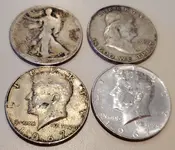blueberra
Full Member
- Joined
- Oct 15, 2009
- Messages
- 219
- Reaction score
- 708
- Golden Thread
- 0
- Location
- Massachusetts
- Detector(s) used
- Deus XP
- Primary Interest:
- Metal Detecting
First, a little backstory.
My primary and secondary dump banks have had broken coin machines for months, so I've been using Plan C.
This week, Plan B was finally fixed, but the display was a little different. I suspect there may have been a software update as well along with the repair (which I believe was some kind of broken sensor leading to misclassification of coins).
In any event I was $130 into dumping this week's (skunk -- naturally) box of halves when the machine stopped. I knew the half dollar bag was full, but the display was grayed out.
The teller (who, I believe, was a new hire) came over and verified that the bag was full.
When he opened the machine, the internal reject bin was almost full. I made note of it and asked him what the bank did with those coins. He kind of mumbled that he didn't know and then said the bank maybe would do something with them.
While he was tending to the machine, I started going through the bin, all the while continuing my conversation.
As I found junk like a screw, an elongated penny, a bent quarter, and a key, I brought them to his attention and put them aside.
I continued to filter through the coins and, along the way, culled eight half dollars -- four of which were clad and four (pictured) were not.
There must have been 50 coins in the bin and virtually all of them seemed like valid, undamaged U.S coins. I only grabbed the halves and, frankly, there might have been more of them if I could have examined the entire contents of the bin.
What I don't understand is the sheer volume of seemingly perfectly good coins that made it to the INTERNAL reject bin. I'm not sure if this phenomenon has any correlation with the machine repair, but I've never seen anything remotely like it in the past.
Truth be told, the machine did eat one of my halves -- maybe it was one of the 4 clad halves that I 'stole' from the internal reject bin.
BTW, the Walking Liberty is a mintmarked 1920, but so worn that I can't determine if it's a D or S.
My primary and secondary dump banks have had broken coin machines for months, so I've been using Plan C.
This week, Plan B was finally fixed, but the display was a little different. I suspect there may have been a software update as well along with the repair (which I believe was some kind of broken sensor leading to misclassification of coins).
In any event I was $130 into dumping this week's (skunk -- naturally) box of halves when the machine stopped. I knew the half dollar bag was full, but the display was grayed out.
The teller (who, I believe, was a new hire) came over and verified that the bag was full.
When he opened the machine, the internal reject bin was almost full. I made note of it and asked him what the bank did with those coins. He kind of mumbled that he didn't know and then said the bank maybe would do something with them.
While he was tending to the machine, I started going through the bin, all the while continuing my conversation.
As I found junk like a screw, an elongated penny, a bent quarter, and a key, I brought them to his attention and put them aside.
I continued to filter through the coins and, along the way, culled eight half dollars -- four of which were clad and four (pictured) were not.
There must have been 50 coins in the bin and virtually all of them seemed like valid, undamaged U.S coins. I only grabbed the halves and, frankly, there might have been more of them if I could have examined the entire contents of the bin.
What I don't understand is the sheer volume of seemingly perfectly good coins that made it to the INTERNAL reject bin. I'm not sure if this phenomenon has any correlation with the machine repair, but I've never seen anything remotely like it in the past.
Truth be told, the machine did eat one of my halves -- maybe it was one of the 4 clad halves that I 'stole' from the internal reject bin.
BTW, the Walking Liberty is a mintmarked 1920, but so worn that I can't determine if it's a D or S.
Attachments
Upvote
9




